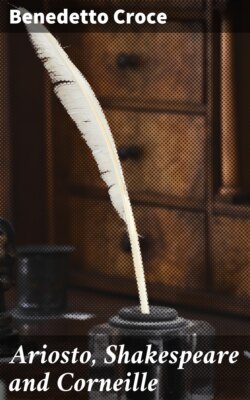Ariosto, Shakespeare and Corneille

Реклама. ООО «ЛитРес», ИНН: 7719571260.
Оглавление
Benedetto Croce. Ariosto, Shakespeare and Corneille
Ariosto, Shakespeare and Corneille
Table of Contents
PART I. LUDOVICO ARIOSTO
CHAPTER I
CHAPTER II. THE LIFE OF THE AFFECTIONS IN ARIOSTO, AND THE HEART OF HIS HEART
CHAPTER III. THE HIGHEST LOVE: HARMONY
CHAPTER IV. THE MATERIAL FOR THE HARMONY
CHAPTER V. THE REALISATION OF HARMONY
CHAPTER VI. HISTORICAL DISASSOCIATIONS
PART II. WILLIAM SHAKESPEARE
CHAPTER VII. THE PRACTICAL PERSONALITY AND THE POETICAL PERSONALITY
CHAPTER VIII. SHAKESPEAREAN SENTIMENT
CHAPTER IX. MOTIVES AND DEVELOPMENT OF SHAKESPEARE'S POETRY. I. THE "COMEDY OF LOVE"
2. THE LONGING FOR ROMANCE
3. SHAKESPEARE'S INTEREST IN PRACTICAL ACTION
4. THE TRAGEDY OF GOOD AND EVIL
5. THE TRAGEDY OF THE WILL
6. JUSTICE AND INDULGENCE
7. IDEAL DEVELOPMENT AND CHRONOLOGICAL SERIES
CHAPTER X. THE ART OF SHAKESPEARE
CHAPTER XI. SHAKESPEAREAN CRITICISM
CHAPTER XII. SHAKESPEARE AND OURSELVES
PART III. PIERRE CORNEILLE
CHAPTER XIII. CRITICISM OF THE CRITICISM
CHAPTER XIV. THE IDEAL OF CORNEILLE
CHAPTER XV. THE MECHANISM OF THE CORNELIAN TRAGEDY
CHAPTER XVI. THE POETRY OF CORNEILLE
Отрывок из книги
Benedetto Croce
Published by Good Press, 2019
.....
Had Ariosto been a philosopher or a poet-philosopher, he would have given us a hymn to Harmony, similar to a good many others which are to be found in the history of literature, celebrating that lofty Idea, which enabled him to understand the discordant concord of things and while satisfying his intellect, filled his soul with peace and joy. But Ariosto was the opposite of a philosopher, and certainly, were he able to read what we are now investigating and discovering in him, first he would be astonished, then he would smile and finally he would comment upon our work with some good-natured jest.
His love for Harmony never took the form of a concept, it was not love of the concept and of the intelligence, that is to say of things answering to a need which he did not experience: it was love for Harmony directly and ingenuously perceived, for sensible Harmony: a harmony, therefore, which did not arise from a loss of his humanity and an abandonment of all particular sentiments, a religious mounting up to the world of the ideas, but existed for him rather as a sentiment among sentiments, a dominant sentiment, surrounding all the others and assigning to each its place. In this respect, he really belonged to one of the chief spiritual currents of the period of the Renaissance, or more accurately, of the early Cinquecento: to the period, that is to say, when Leonardo, Raphael, Fra Bartolommeo, Andrea del Sarto, with their beautiful, harmonious decorum and majestic forms, had succeeded to Ghirlandaio, to Botticelli, to Lippi, when it seemed (in the words of Wölfflin, a historian of art) "as though new bodies had suddenly grown up in Italy," a new and magnificent population, resplendent in painting and sculpture, which was indeed the reflection of a new psychical attitude, of a different direction and of a new centre of interest.
.....